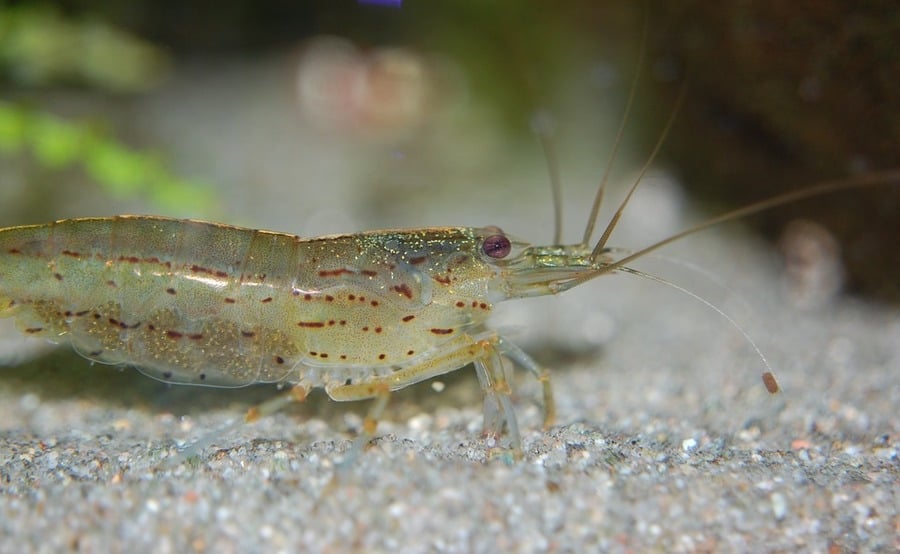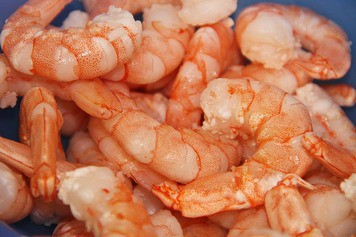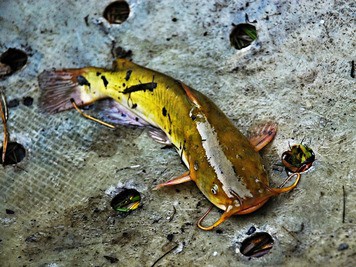Shrimp as Freshwater Bait (Complete Guide)
Leave a comment after this article and let’s talk more about fishing. I’d love to read your feedback.
Can you use shrimp as bait in freshwater? Live freshwater shrimp can be a great bait option for bass, panfish, catfish, trout, and trout. Dead saltwater shrimp can be a great bait option for catfish, bluegills, and even carp.
If you are going to fish with shrimp, you must know how to effectively use it. Read on to get a complete understanding of shrimp as a potential freshwater bait item.

Table of Contents
Shrimp as a Freshwater Bait
| Shrimp Type | Preparation | Target Fish | Best Applications |
|---|---|---|---|
| Raw Shrimp | Peeled or unpeeled, whole or cut into pieces | Catfish, Carp, Panfish | Bottom fishing, suspended under a bobber. |
| Cooked Shrimp | Peeled, often cut into smaller pieces | Trout, Bass, Panfish | Used on smaller hooks for casting or drifting. |
| Salted Shrimp | Whole or cut, with added salt for preservation | Catfish, Carp, Sturgeon | Bottom fishing in slower-moving waters. |
| Scented/Flavored Shrimp | Often pre-packaged, enhanced with attractants | Catfish, Bass, Walleye | Useful in murky waters or for finicky fish. |
| Frozen Shrimp | Thawed and used whole or cut into pieces | Catfish, Carp, Striped Bass | Bottom fishing or drifting in deeper areas. |
There are countless varieties of freshwater shrimp around the world. Chances are your country has at least one kind. For example, in areas of the southeastern United States, there are a couple of different species of freshwater shrimp.
For a complete breakdown of what fish will bite worms, check out this article.
These shrimp inhabit murky, warmer bodies of moving water. If caught fresh, freshwater shrimp can be a great live bait option for a whole variety of game fish.
Freshwater shrimp are a very popular bait in parts of Australia. Many recreational anglers trap their own shrimp for fishing.

Saltwater shrimp, on the other hand, limits your fishing options some. You aren’t going to catch fish that prefer live bait like bass, walleye, pickerel, and trout with dead saltwater shrimp.
Target species for saltwater shrimp are primarily catfish, bullheads, and bluegills. Common carp will also bite shrimp if presented.
When fishing with dead saltwater shrimp, you can opt for raw shrimp or cooked shrimp. They will both work well. I would recommend removing the shell though.
With bluegills, you’ll want to just use a piece of the shrimp unless you are using very small cocktail shrimp as bait.
Click here to find out how to properly bait worms on a hook. You may also be interested in using marshmallows as fishing bait.
What Freshwater Fish Can You Catch with Shrimp?
Live Freshwater Shrimp
- Bass
- Crappie
- Bluegills
- Trout
- Yellow Perch
- Chain Pickerel
- Catfish
- Bullheads
- Walleye
Dead Saltwater Shrimp
- Catfish
- Bullheads
- Common Carp
- Bluegills (though they prefer live freshwater shrimp)
If you want to learn how to use squid as bait for big freshwater fish, check out this article.
Shrimp vs. Other Live Bait
Freshwater shrimp can be just as effective a bait as minnows, crayfish, and even worms in some bodies of water. Lively shrimp are a natural part of the food chain and panfish, trout, catfish, bullheads, and bass will devour a hapless shrimp it finds out in the open.
These freshwater shrimp are easy to catch and hold well in a live-well or aerated bucket. They will also remain alive on a hook for a while and draw in curious, hungry fish.
Saltwater shrimp won’t work for bass, trout, and other active predators. Scavenging type of the game fish like bullheads, catfish, bluegills, and even common carp are going to be your target species here.
For catfish and bullheads, I’d rank dead shrimp behind worms, minnows, and cut bait. For bluegills, pieces of shrimp can be every bit as effective for bluegills as most live bait with the exception of minnows and worms.
A study by Hein & Crowl (2010) may indicate that freshwater shrimp are under such threat from fish that they will move upstream above waterfalls to avoid being eaten.
If you would like to catch your own freshwater shrimp, check out this bait trap available on Amazon. I like the design of this trap since shrimp will head into the trap seeking shelter from hungry fish. Place this trap along the shoreline for best results. You can also add some bread to catch minnows, shiners, and crayfish.
Best Water Conditions to Use Shrimp in Freshwater
Shrimp can be used in a variety of water types and situations but they really shine in specific settings. I would not recommend ever fishing shrimp in very clear water. The only exception to this is for bluegills on late summer evenings.
When fishing with freshwater shrimp, your best bet is to fish in the same water you catch them at. Not every game fish sees freshwater shrimp in their body of water.
If you really want to elicit an aggressive response, show the game fish (be it bluegill, trout, bass, etc) a live shrimp out in the open they otherwise only get to see darting into vegetation near the shore.
Do this and they’ll devour it. Fish freshwater shrimp in muddy, gently flowing water for the best results.
Raw or cooked shrimp can be fished in virtually any clarity of the water. You can even use canned shrimp for good success with bullheads and catfish.
Just remember, the clarity of the water does not matter with dead shrimp. What really matters is the species you’re fishing for. Catfish, bullheads, and carp prefer muddy, slow water. Bluegills generally do too but they will bite pieces of shrimp in relatively clear water too.
At the end of the day, it doesn’t matter so much the type of water you fish with dead shrimp in. Just find your fish and you should catch something.
Bait Tips: Shrimp for Freshwater Fishing
1. Canned for Cats
A great way to catch catfish is by using canned shrimp. Canned shrimp oftentimes is fishier in taste and scent than cooked or even raw shrimp.
This extra “potency” will draw in catfish, especially at night when they can’t see what they are hunting for.
2. Peel the Shrimp
If you are going to fish with dead saltwater shrimp, don’t offer fish a shelled shrimp. Saltwater shrimp shells are far tougher than freshwater shrimp’s shells which are more delicate.
If you really want a catfish or carp to grab onto your bait, make it as inviting and manageable as you can. This also applies to pieces of shrimp you present bluegills.
3. Smaller Pieces for Bluegills
Bluegills have abnormally small mouthparts. This means they aren’t able to consume bigger meals. Make it easier on them by breaking off a small chunk of shrimp and putting that on the hook.
Not only will bluegill not be able to bite onto a full-sized shrimp, it likely won’t even consider it a possible food source. You can also try baby shrimp as they work very well for bluegills.
4. Go Big for Big Catfish

If you are after large catfish, select the biggest shrimp you can find. I’m not saying to go buy tiger prawns as that would be way too expensive and the bait too intimidating for most catfish.
What I’m saying is jumbo frozen (thawed of course) shrimp really attract catfish. Big catfish will grab onto jumbo shrimp and not want to release.
5. Catch Shrimp Where You Fish
When fishing with live freshwater shrimp, it is a great practice to catch the shrimp right there on the shoreline. I say this for two reasons.
The first is it is oftentimes illegal to relocate shrimp from one body of water to another. You can get into real trouble if you do this form of “bucket biology”.
The second is fish will already recognize these shrimp as a food source and will know exactly what to do with them.
6. Only Use the Healthiest Ones
Bluegills, bass, trout, and walleye prefer healthy natural prey to sickly ones. If you have access to a shoreline full of freshwater shrimp, don’t settle for a less than supreme specimen to fish with.
No. Grab the healthiest, most robust shrimp you can find and them him do all the work for you. The most active shrimp will be the one the fish key in on.
7. Make the Shrimp Sweat
Freshwater shrimp spend most of their time cowering around shoreline vegetation or eating detritus off the bottom of the stream. They aren’t used to being free-swimming out in the open.
Put them there. A helpless shrimp out in the open will draw so many fish eyes, you be able to set the hook fast enough. If you want to catch fish with shrimps, make the shrimp as vulnerable as you can.
Don’t let it sink to the bottom. Keep it out in the open.
8. Burley or Corn Meal
To draw in fish from ways away, toss some cornmeal into the water. For even better results, check out this in-depth complete guide to making your own burley. I spent a lot of time researching this article and all these methods are proven to work.
You can draw in fish from many yards away with a good burley slick. Shrimp alone will work well but combine them with a burley or cornmeal attractant, you’ll be cooking with gasoline.
9. Bottom with Saltwater Shrimp
Place dead saltwater shrimp where you’ll find hungry fish wanting to eat it. I’m talking mostly about bullheads, carp, and catfish. These fish are bottom-dwellers and constantly rummaging through the muck in search of living and dead things.
Give them the dead thing they would love to eat. Don’t waste your time using a float. Just tie a weight to the shrimp and let it fly. Once your line starts moving, set the hook hard.
10. Suspend Freshwater Shrimp
Freshwater shrimp are the exact opposite. Keep them out in the open away from cover and predatory fish will find them in a hurry.
Shrimp are hard for most fish to catch when they are hanging around cover. If they find one stuck out in the open, they will attack it.
Related Questions
What freshwater fish eat shrimp?
Freshwater fish have varied diets, and many species do eat shrimp. Shrimp can be an essential part of their diet, providing valuable protein and nutrients. Some common freshwater fish that eat shrimp include cichlids, angelfish, and certain species of catfish. It is important to consider the specific needs and behavior of each fish species when determining their diet.
Will bass eat shrimp?
Bass will eat shrimp. Shrimp are a common prey for bass due to their high protein content. Bass are opportunistic feeders and will readily consume shrimp if given the chance. Shrimp can be an effective bait option when targeting bass in both freshwater and saltwater environments.
Are shrimp naturally found in freshwater?
There are countless species of freshwater shrimp found throughout the world. From what I’ve read, most prefer slow-moving water to live in.
Can fly fishermen take advantage of natural shrimp?
There are a number of freshwater shrimp imitation nymphs on the market. These work especially good on brown trout and big rainbows.
